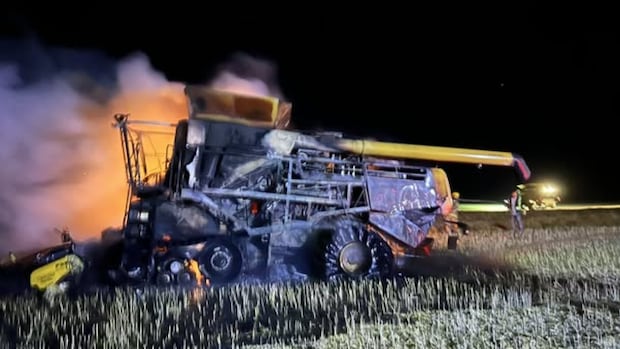Saskatchewan·NewFarmers working to get the last of their crops in the bin this harvest season are contending with a spike in costly and dangerous equipment fires, which in some cases resulted in the total loss of million-dollar combines, according to the latest crop report.Crop report reminds producers to keep fire mitigation resources handyColleen Silverthorn · CBC News · Posted: Oct 08, 2025 6:00 AM EDT | Last Updated: 30 minutes agoSaskatchewan’s Ministry of Agriculture says it’s hearing from farmers about an increase in machinery fires, like this combine that burned near Zenon Park, about 220 kilometres northeast of Saskatoon. (Zenon Park and District Fire Department/Facebook)Farmers working to get the last of their crops in the bin this harvest season are contending with a spike in costly and dangerous equipment fires, which in some cases resulted in the total loss of million-dollar combines, according to the latest crop report.Kelly Dorosh is chief for the Biggar and Rural District Fire Association, which provides fire coverage for three rural municipalities including Biggar, about 90 kilometres west of Saskatoon. He said his department has responded to several combine fires this fall.”One larger one, north of town, that went into a forest-like setting — that one was a bit of a challenge. Then [there was] another one a couple of days after that,” Dorosh said, adding a lack of moisture and limited rainfall has created tinder-dry, easily combustible crops.Dorosh said the fire department was able to save the combine in one of the fires, but the other one was completely destroyed.He said farmers are well-educated in preventing machinery fires. Many keep water trucks on standby and tillage equipment nearby to create fireguards.But sometimes, it’s still not enough.”Simple as them [combines] picking up a small rock, it’s bouncing through there on metal, creating sparks, and it’s falling into the driest tinder that it could fall into,” Dorosh said.Crop report warningWhile Dorosh hasn’t observed worse equipment fires this year than other years, the people who compile the Ministry of Agriculture’s weekly crop report said they’re getting more farmers sending in reports about equipment fires this harvest.It was enough to prompt the organization to include a warning in its Oct. 2 crop report: “With an increase in the number of machinery fires being reported, we would like to remind producers to have fire mitigation resources ready, blow off their combines regularly and take precautions when working around power lines.”Tyce Masich, a crops extension specialist who works on the crop report, said the Ministry doesn’t have statistics on machinery fires, but he said they are getting more reports on them from farmers this fall than in previous years.”Machinery, it can get pretty hot inside the engine and of course that’s a fire risk when you’re operating on dry material, dry stubble,” he said.Masich said used combines can cost several hundred thousand dollars and new machines top $1 million. The lost production time is also costly for producers.Powdery mildew also a factorKaeley Kindrachuk, an agronomist with Sask Oilseeds, said a major culprit in this fall’s fires is the prevalence of powdery mildew, a late season disease of canola crops that creates a thick white dust that coats equipment and the inside of machinery.”When the machinery heats up, the dust heats up, and that’s what causes the fires,” Kindrachuk said.Sask Oilseeds is getting reports of powdery mildew from several areas in the province, she said.White dust from powdery mildew can get into equipment and cause fires. (Christine Bennink/Canola Council of Canada)The moist, foggy mornings provided a prime environment for the disease to develop, Kindrachuk said.”It’s not very common. It doesn’t show up every year,” she said. “It’s quite sporadic and hard to predict when we’re going to see it.”Kindrachuk said powdery mildew generally doesn’t affect crop yields because it occurs later in the season.”If you are in a field where there’s a lot of powdery mildew you might have to clean your equipment more than once, more than twice. Just keep an eye on it.”
Dry conditions, crop disease spark increase in equipment fires in Sask., agronomists say











